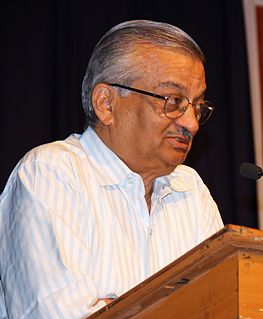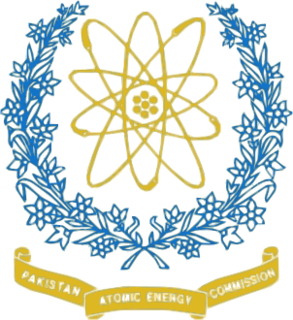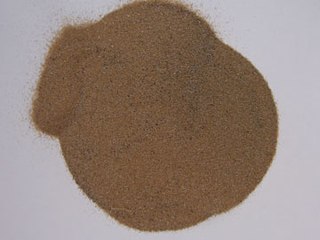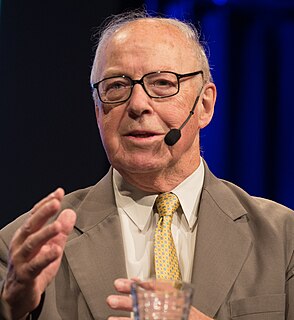
Nuclear power is the use of nuclear reactions that release nuclear energy to generate heat, which most frequently is then used in steam turbines to produce electricity in a nuclear power plant. As a nuclear technology, nuclear power can be obtained from nuclear fission, nuclear decay and nuclear fusion reactions. Presently, the vast majority of electricity from nuclear power is produced by nuclear fission of uranium and plutonium. Nuclear decay processes are used in niche applications such as radioisotope thermoelectric generators. Generating electricity from fusion power remains at the focus of international research. This article mostly deals with nuclear fission power for electricity generation.

A breeder reactor is a nuclear reactor that generates more fissile material than it consumes. Breeder reactors achieve this because their neutron economy is high enough to create more fissile fuel than they use, by irradiation of a fertile material, such as uranium-238 or thorium-232 that is loaded into the reactor along with fissile fuel. Breeders were at first found attractive because they made more complete use of uranium fuel than light water reactors, but interest declined after the 1960s as more uranium reserves were found, and new methods of uranium enrichment reduced fuel costs.

Areva S.A. was a French multinational group specializing in nuclear power and renewable energy with headquartered in Paris, France. Before restructuring Areva was majority owned by the French state, through French Alternative Energies and Atomic Energy Commission (54.37%), Banque publique d'investissement (3.32%), and Agence des participations de l'État (28.83%). Moreover, Électricité de France of which the French government has a majority ownership stake, owned 2.24%; Kuwait Investment Authority owned 4.82% as the second largest shareholder after the French state. It was also listed at Euronext. As a part of the restructuring program after insolvency, Areva sold out or discontinued its renewable energy businesses, sold its reactors business subsidiary Areva NP to EDF and nuclear nuclear propulsion and research reactors subsidiary Areva TA to Agence des participations de l'État, and separated nuclear cycle business into a separate company New Areva. As a results, Areva S.A. became a wholly state-owned by the French Government, and it stayed responsible only for the liabilities related to the Olkiluoto 3 project in Finland, as well for a holding of 40% stake in Orano.
In nuclear physics, an energy amplifier is a novel type of nuclear power reactor, a subcritical reactor, in which an energetic particle beam is used to stimulate a reaction, which in turn releases enough energy to power the particle accelerator and leave an energy profit for power generation. The concept has more recently been referred to as an accelerator-driven system (ADS) or Accelerator-driven sub-critical reactor.

Anil Kakodkar is an Indian nuclear physicist and mechanical engineer. He was the chairman of the Atomic Energy Commission of India and the Secretary to the Government of India, he was the Director of the Bhabha Atomic Research Centre, Trombay from 1996–2000. He was awarded the Padma Vibhushan, India's second highest civilian honour, on 26 January 2009.

A molten salt reactor (MSR) is a class of nuclear fission reactor in which the primary nuclear reactor coolant and/or the fuel is a molten salt mixture. MSRs offer multiple advantages over conventional nuclear power plants, although for historical reasons, they have not been deployed.

The EPR is a third generation pressurised water reactor (PWR) design. It has been designed and developed mainly by Framatome and Électricité de France (EDF) in France, and Siemens in Germany. In Europe this reactor design was called European Pressurised Reactor, and the internationalised name was Evolutionary Power Reactor, but it is now simply named EPR.
Uranium-233 is a fissile isotope of uranium that is bred from thorium-232 as part of the thorium fuel cycle. Uranium-233 was investigated for use in nuclear weapons and as a reactor fuel. It has been used successfully in experimental nuclear reactors and has been proposed for much wider use as a nuclear fuel. It has a half-life of 160,000 years.

Generation IV reactors are a set of nuclear reactor designs currently being researched for commercial applications by the Generation IV International Forum, with technology readiness levels varying between the level requiring a demonstration, to economical competitive implementation. They are motivated by a variety of goals including improved safety, sustainability, efficiency, and cost.

The Pakistan Atomic Energy Commission is an independent governmental authority and a scientific research institution, concerned with research and development of nuclear power, promotion of nuclear science, energy conservation and the peaceful usage of nuclear technology.

The liquid fluoride thorium reactor is a type of molten salt reactor. LFTRs use the thorium fuel cycle with a fluoride-based, molten, liquid salt for fuel. In a typical design, the liquid is pumped between a critical core and an external heat exchanger where the heat is transferred to a nonradioactive secondary salt. The secondary salt then transfers its heat to a steam turbine or closed-cycle gas turbine.
The Jules Horowitz Reactor is a Material Test Reactor (MTR) cooled and moderated with water. It is under construction at Cadarache in southern France, based on the recommendations of the European Roadmap for Research Infrastructures Report, which was published by the European Strategy Forum on Research Infrastructures (ESFRI) in 2006. The reactor, which is named for the 20th-century French nuclear scientist Jules Horowitz, is expected to begin operation in 2021.

India's three-stage nuclear power programme was formulated by Homi Bhabha in the 1950s to secure the country's long term energy independence, through the use of uranium and thorium reserves found in the monazite sands of coastal regions of South India. The ultimate focus of the programme is on enabling the thorium reserves of India to be utilised in meeting the country's energy requirements. Thorium is particularly attractive for India, as it has only around 1–2% of the global uranium reserves, but one of the largest shares of global thorium reserves at about 25% of the world's known thorium reserves. However, thorium is more difficult to use than uranium as a fuel because it requires breeding, and global uranium prices remain low enough that breeding is unnecessary.
The FUJI molten salt reactor is a proposed molten-salt-fueled thorium fuel cycle thermal breeder reactor, using technology similar to the Oak Ridge National Laboratory's Molten Salt Reactor Experiment - liquid fluoride thorium reactor. It was being developed by the Japanese company International Thorium Energy & Molten-Salt Technology (IThEMS), together with partners from the Czech Republic. As a breeder reactor, it converts thorium into the nuclear fuel uranium-233. To achieve reasonable neutron economy, the chosen single-salt design results in significantly larger feasible size than a two-salt reactor. Like all molten salt reactors, its core is chemically inert and under low pressure, helping to prevent explosions and toxic releases. The proposed design is rated at 200 MWe output. The IThEMS consortium planned to first build a much smaller MiniFUJI 10 MWe reactor of the same design once it had secured an additional $300 million in funding.
No nuclear power plant has ever been established in Norway; however, the country has a legal framework for licensing the construction and operation of nuclear installations. Also, four research reactors have been built in Norway, the first was JEEP I which was operative from 1951 to 1966. Two research reactors are currently operative, the Halden Reactor and JEEP II at Kjeller. There has been discussions about the possible usage of nuclear energy, which is supported by some industry leaders. Statkraft together with Vattenfall, Fortum and the energy investment company Scatec announced plans to investigate building of a thorium-fueled power plant in 2007 which was never realized. In 2010, Aker Solutions purchased patents from Nobel Prize winning physicist Carlo Rubbia for the design of a proton accelerator-based thorium nuclear power plant, but was subsequently sold to Jacobs Engineering Group in 2011. In late 2012, Norway's privately owned Thor Energy, in collaboration with the government and Westinghouse, announced a four-year trial using thorium in an existing nuclear reactor.

Thorium-based nuclear power generation is fueled primarily by the nuclear fission of the isotope uranium-233 produced from the fertile element thorium. According to proponents, a thorium fuel cycle offers several potential advantages over a uranium fuel cycle—including much greater abundance of thorium on Earth, superior physical and nuclear fuel properties, and reduced nuclear waste production. However, development of thorium power has significant start-up costs. Proponents also cite the lack of easy weaponization potential as an advantage of thorium, while critics say that development of breeder reactors in general increases proliferation concerns. Since about 2008, nuclear energy experts have become more interested in thorium to supply nuclear fuel in place of uranium to generate nuclear power. This renewed interest has been highlighted in a number of scientific conferences, the latest of which, ThEC13 was held at CERN by iThEC and attracted over 200 scientists from 32 countries.
Thorcon is a company that is designing the ThorCon Reactor, a small modular reactor (SMR) that employs molten salt technology, based on the DMSR design from Oak Ridge National Laboratory. It relies on large modules as are used in modern ship building. The ThorCon reactor is a "burner" reactor that employs liquid fuel, rather than a conventional solid fuel; this liquid contains the nuclear fuel and also serves as primary coolant.


















